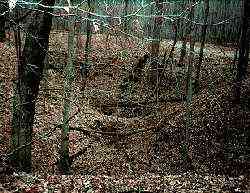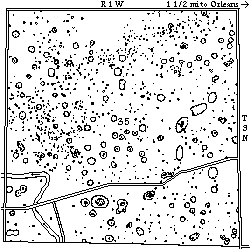Sinkholes
 Solution caves are huge plumbing systems. Rainwater contains small amounts of nitric and carbonic acids. As these dilute acids seep through the cracks and bedding planes in the vadose zone of the bedrock, they slowly dissolve some of the limestone. Over time, the vertical crevices enlarge and literally funnel rainwater into the drainage system below, creating sinkholes. The sinkholes at left are found along a trail in a state park in Owen County.
Solution caves are huge plumbing systems. Rainwater contains small amounts of nitric and carbonic acids. As these dilute acids seep through the cracks and bedding planes in the vadose zone of the bedrock, they slowly dissolve some of the limestone. Over time, the vertical crevices enlarge and literally funnel rainwater into the drainage system below, creating sinkholes. The sinkholes at left are found along a trail in a state park in Owen County.
 Sinkholes form early in the karsting process and are very common. This diagram -- of one section of land just southwest of Orleans, Indiana -- comes from field notes taken by Dr Clyde Mallott and Robert Schrock in 1929. In this one square mile, the two geologists counted 1022 sinkholes; the major karst areas of Indiana are estimated to contain 300,000 of them.
Sinkholes form early in the karsting process and are very common. This diagram -- of one section of land just southwest of Orleans, Indiana -- comes from field notes taken by Dr Clyde Mallott and Robert Schrock in 1929. In this one square mile, the two geologists counted 1022 sinkholes; the major karst areas of Indiana are estimated to contain 300,000 of them.
As you might imagine, few surface streams are found in heavily karsted areas such as the Mitchell Plain. The dry-bed of Lost River, which crosses the southwest corner of this section, carries only the overflow waters when heavy rains fill the subterranean passages.
Diagram courtesy Dr Clyde Mallott / Indiana Academy of Science.